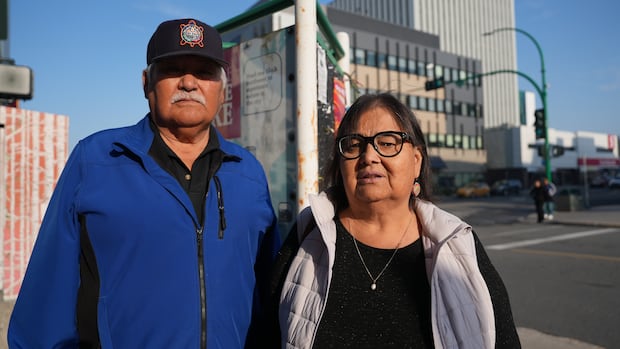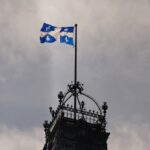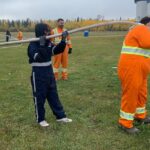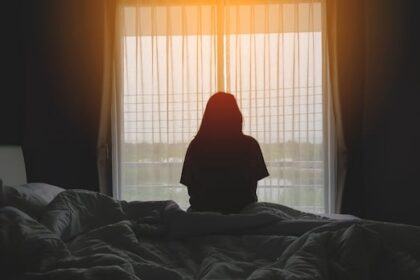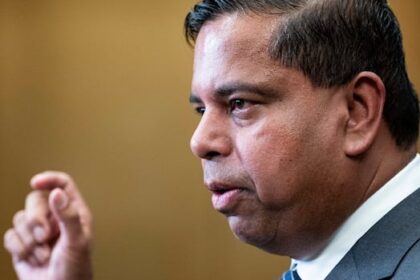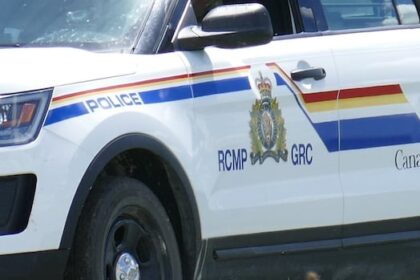NorthThe Truth and Reconciliation Commission’s Call to Action 82 urges governments across Canada to install a residential school monument in every capital city. Plans are underway to build a memorial in Yellowknife by June 2027.Installing a monument in each capital city in Canada is one of the TRC’s calls to actionSamuel Wat · CBC News · Posted: Oct 06, 2025 8:49 PM EDT | Last Updated: October 7Paul Andrew, left, and Doreen Cleary have been long been pushing for a monument in the N.W.T. to honour residential school survivors and victims. (Mohamed-Amin Kehel/Radio-Canada)A monument to honour residential school survivors and victims in Yellowknife now has a likely location: Somba K’e park.Work to build a monument in the Northwest Territories has been in progress for years, and in a request for qualifications — an early stage of the procurement process — the government of the Northwest Territories lists the monument site as beside the playground at Somba K’e park.As co-founder of We Always Remember (WAR), an advocacy group led by residential school survivors in the N.W.T., Doreen Cleary has long pushed for a monument to be built.She said she saw the trauma residential schools had inflicted on her family — some who never returned. “I’ve lost a couple cousins, and my husband passed on, and he suffered in residential school. I’d like to see something like this [monument] to remember him by, and people will remember him,” she said. Paul Andrew, another co-founder of WAR, said there are young people who don’t even realize they have family members who went to residential schools. “For some of us, it’s really difficult to talk about what happened to us, especially with our children. Hopefully [this is] what this monument will do,” he said. Andrew hopes the monument can serve as a reminder of the work on reconciliation that still remains. “We don’t want people to forget the recommendations of the Truth and Reconciliation Commission. We don’t want people to just hire more Indigenous people or put Indigenous arts on the walls. That’s not enough. We want them to live up to some of the really basic changes and attitudes, and that requires a little bit more work.”Marie Wilson, former commissioner on the Truth and Reconciliation Commission, says a monument is an important way to ensure the impacts of residential schools continue to be remembered for years to come. She says many Canadians she’s spoken to say they didn’t learn this history in school. (Samuel Wat/CBC )The Truth and Reconciliation Commission’s Call to Action 82 urges governments across Canada to install a residential school monument in every capital city. Few provinces and territories have done that, but the N.W.T. government is aiming to have a memorial up by June 2027. A place that nurtures healingMore than 150,000 First Nations, Métis and Inuit children were sent to residential schools across the country. The N.W.T. has more survivors per capita than anywhere else in Canada, according to the N.W.T. government. Katherine Robinson, a senior advisor to the deputy minister of executive and Indigenous affairs, said in the spirit of reconciliation, residential school survivors are the ones leading the decision around the vision for the monument. Work on the project began in 2021. Robinson admits there have been some roadblocks caused by wildfires and territorial elections, but she believes there’s good progress being made. “We’re back on track and have been meeting regularly with the survivors and moving through the procurement process since January of this year,” she said. People gathered for a vigil at Somba K’e Park in Yellowknife in 2021. Marie Wilson, former commissioner on the Truth and Reconciliation Commission, believes the monument could help make the park a sacred space for gatherings. (Liny Lamberink/CBC)Standing next to the playground at Somba K’e park, Marie Wilson looks fondly at the blue water, rugged rocks and fall foliage that surrounds the site. She served as one of three commissioners of the Truth and Reconciliation Commission of Canada. She said that years ago the territorial government brought together a group lead by residential school survivors to discuss a vision for the monument.”They wanted to be able to show the severing of children from family. They wanted it also to be a place that nurtured healing. So that’s why the proximity to water, for example, the proximity to all these beautiful trees and the rock that’s behind us, all of these natural elements that are so much a part of Indigenous identity,” Wilson said.”They wanted to have a space that was big enough for the potential of a sacred fire, should they choose to do that. They wanted to have lots of room so that people could gather in big numbers for things like the National Day for Truth and Reconciliation.”The N.W.T. government has put a call out for ideas for what the monument could look like. The deadline for requests for qualifications for Indigenous artists from the N.W.T. and Nunavut is Oct. 17. ABOUT THE AUTHORSamuel Wat is a senior writer for CBC North, based in Yellowknife. He has worked as a producer and reporter with CBC in Iqaluit and Ottawa, and for public and state broadcasters in New Zealand before that. You can reach him at samuel.wat@cbc.caWith files from Mohamed-Amin Kehel
Monday, 24 Nov 2025
Canada – The Illusion
Search
Have an existing account?
Sign In
© 2022 Foxiz News Network. Ruby Design Company. All Rights Reserved.
You May also Like
- More News:
- history
- Standing Bear Network
- John Gonzalez
- ᐊᔭᐦᑊ ayahp — It happened
- Creation
- Beneath the Water
- Olympic gold medal
- Jim Thorpe
- type O blood
- the bringer of life
- Raven
- Wás’agi
- NoiseCat
- 'Sugarcane'
- The rivers still sing
- ᑲᓂᐸᐏᐟ ᒪᐢᑿ
- ᐅᑳᐤ okâw — We remember
- ᐊᓂᓈᐯᐃᐧᐣ aninâpêwin — Truth
- This is what it means to be human.
- Nokoma


